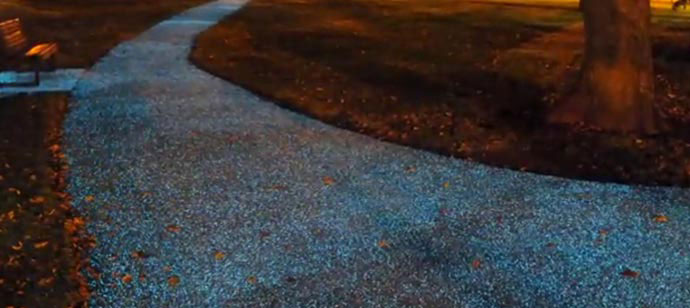Most cyclists would settle for cycle lanes that are direct and well-maintained, but the latest thinking is that they should glow in the dark.
Starpath is a new surface treatment for paths that absorbs energy from the sun during the day and then releases it at night, causing the particles embedded in the ground to glow like a carpet of stars.

British company Pro-Teq claims Starpath offers an environmentally-friendly alternative to street lighting and that its anti-slip properties make it ideal for use on bike paths.
According to the owner of Pro-Teq Surfacing, Hamish Scott: “There is nothing like Starpath in the world, this product adjusts to the natural light, so if it is pitch black outside the luminous natural earth enhances, and if the sky is lighter, it won’t release as much luminosity – it adjusts accordingly.”
Starpath can be quickly and easily applied to existing paths – a 150m stretch currently being trialled in Cambridge was installed and ready to use in less than five hours.
Glowing trees

Trees as street lights
If the glow from a Starpath cycle lane proves insufficient, trees with naturally-glowing leaves could soon illuminate streets without without the need for conventional street lamps. Researchers in Taiwan have discovered that the addition of gold nanoparticles to the leaves of the Bacopa Caroliniana tree causes them to glow.
The glowing plants reduce light pollution while at the same time absorbing CO2.
Dr Yen-Hsun Su at Taiwan’s Cheng Kung University was working on alternatives to LED lights when he discovered that tiny particles of gold caused chlorophyll in the plants to produce a reddish luminescence.
Dr Yen-Hsun Su told Chemistry World: “In the future, bio-LED could be used to make roadside trees luminescent at night. This will save energy and absorb CO2 as the bio-LED luminescence will cause the chloroplast to conduct photosynthesis.”
The wrong kind of lights
With the news this week focussed on the effect that our appetite for energy has on prices, perhaps the time is right to ask why so many lights are left on. Office buildings in cities routinely leave lights on overnight and many street lamps remain on through the small hours.
We take a one-size-fits-all approach to street lighting, but the needs of pedestrians and motorists are different.
If organisations responsible for lighting, as part of their planned maintenance and replacement programmes, devised provision for driving and walking separately they would be able to turn off the lights for drivers, but keep on the lower-powered lights for pedestrians. Naturally, this would generally only apply to main roads, but the savings in energy would be worthwhile. In some cases, glow-in-the-dark paths and luminescent trees could play a role.
Ian Byrne
We tried partial switching off of road lights in Milton Keynes, where the through “grid” roads are largely segregated from pedestrian and cycle paths (the Redways). However it was abandoned after a few months, due to increased road accidents (I believe including some fatalities). Most people didn’t like it, and it did also show up some places where the redway lighting was poor and dependent on spilled light from the main grid roads. The Council have now moved to LED lighting where possible on both grid roads and redways, and claim that they are saving more energy. And I suspect that had they reduced the hours of switching lights off to the middle of the night (say 1 to 5 am) they might have found no real effect on road safety. But I find the LED lights selected rather too harsh for the cycle paths, with pooling of light – bright then dark the bright…
Karl Drinkwater
Sounds pretty horrible to me. Bio-engineered trees and wasteful chemicals? Hardly a green future bicycles can be a part of. The minority of cycle trips are in the dark, just use bike lights. The law says you’ve got to have them anyway, and since few journeys would purely be on this kind of path (usually you’ve still got to go across roads etc) you’d still need lights.
Ingrid O’Donnell
Just think the advancements in technology are amazing. Not all solutions will fit every situation, but it is good to have an increased choice of solutions. Solar-Candela’s high-efficiency solar street lights for off-grid situations specially designed for UK conditions provide another means of illuminating cycle paths and potential hazard points.